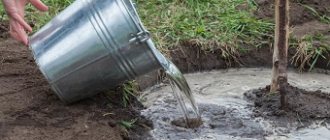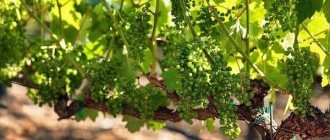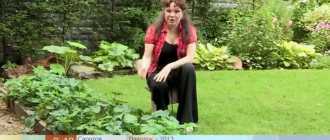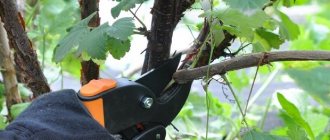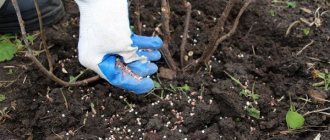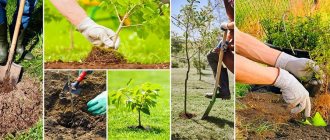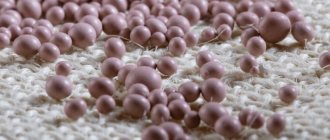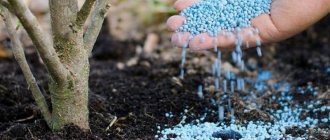Fertilizing the apple tree in the fall
The main task of autumn care is to prepare the apple tree for hibernation and provide nutrition from autumn to spring. For this purpose, a variety of organic and chemical agents are used, which are applied either individually or combined with each other.
During this growing season, the main thing is to protect the tree from adverse weather conditions, especially the root system. It is to strengthen the plant before anabiosis (hibernation) that a certain set of nutrients is used. We will tell you in more detail about what is needed to support plants in the fall, and what preparations should absolutely not be used.
After harvesting, the apple tree needs autumn fertilizing to replenish the large amount of costs for fruit formation. Nutrients are necessary to strengthen the tree for the winter and normal growth next year.
Advice from experienced fruit growers
Let us share the secrets of experienced gardeners and professional experts:
- Long-lived apple trees are considered to be varieties of Soviet selection (Antonovka, Autumn Striped, Papirovka) and their scions.
- The trend in agricultural business in the world is planting the latest hybrid varieties . Features: rapid development, abundant (giant) fruiting in the first years of life and aging by 8 years.
- When planting apple trees, you need to take into account the characteristics of the region . Released varieties, as a rule, quickly adapt to a certain climate and bear fruit for a long time and stably.
- When choosing a variety, it is important to know that southern varieties, despite their early ripening, large size and juiciness of fruits, are less winter-hardy. And Siberian, Altai varieties and apple trees of Yekaterinburg selection tolerate winter well and are not inferior in taste to “southerners”.
- When harvesting even late-ripening varieties, it is better to pick the fruits when they are green , that is, not fully ripe. 1-2 weeks before full ripening, the apples are carefully removed from the tree; the fruits will ripen during storage.
- A timely harvest activates the formation of next year's buds (space is freed up for bud formation).
- The optimal way to store winter apples is to put the fruits in a box, sprinkle them with a mixture of fluff lime and sawdust in a ratio of 1:2 or 1:1. No more than 2-3 layers are placed in the box.
The role of mineral fertilizers in autumn feeding of apple trees
The most common macroelements necessary for plant nutrition are nitrogen, phosphorus, and potassium.
- Nitrogen is responsible for the growth of green mass - leaves and stems.
- Phosphorus is involved in the formation of hair-like roots that absorb nutrients. They also participate in the formation of cellulose, starch, glucose, sucrose - the main building materials of plants.
- The main task of potassium is to retain nutrients in plant tissues and protect cells from harmful interference. In other words, the element performs a strengthening and protective function.
Intensive processes of growth of leaves and stems occur in spring and early summer. Then, the “biological program” switches to flowering and fruiting, processes in which nitrogen is minimally involved. Therefore, in the middle of summer they are introduced in minimal quantities, and in August they are canceled altogether.
The element should not be present in autumn fertilizing, since during this growing season artificial stimulation of the growth of leaves and stems is extremely undesirable. If new shoots grow closer to autumn, they will not have time to gain strength by winter and will freeze. But not only they will suffer, but also the old branches from which they grew.
For this reason, mineral nitrogen fertilizers for autumn feeding are not applied to the soil. They are used only for spraying the crown because they act as a fungicide . Find out also → types of nitrogen fertilizers, application.
Autumn processing of apple trees
In addition to crown pruning and fertilizing, garden trees also need preventative spraying. It is advisable to perform this procedure after forming the crown and removing fallen leaves. To prevent infection by fungal infections and to combat the main “apple” pests, almost identical compositions are used.
Before processing, it is necessary to inspect the trunk and branches. The growths and lichens are removed manually (you can use a knife or a metal brush). Damaged areas must be treated with a concentrated 1% solution of copper sulfate. After pruning the branches, garden varnish or paint is used - this will protect the plant from infections.
Spraying and treating apple trees in autumn:
- Bordeaux mixture is used to combat scab and other fungal diseases. It is very easy to prepare: dilute 300 grams of copper sulfate in 5 liters of water, and 400 grams of lime separately in the same volume. The resulting mixtures are combined and sprayed.
- Copper sulfate will help get rid of fruit rot and codling moths. To spray the tree, use a 1% solution. The tree trunk circle is treated with a 3% solution.
- The tree trunk circle is treated with a urea solution (about 200 grams per bucket of water) to destroy pests hidden for the winter.
- In case of severe damage to the bark by lichens or black cancer, the method of treatment with a solution of iron sulfate (50 grams per liter of water) is used; after complete disinfection, the trunk can be whitened.
- You can use ready-made preparations that are diluted in water immediately before spraying (efficiency decreases during storage). The most popular are “Karbofos”, “Fitosporin”, “Oxychom”, “Fundazol” and others.
You may be interested in: Fertilizing pears in the fall, timing of fertilization
Autumn treatment of apple trees is carried out with a manual or automatic sprayer. It is imperative to use protective equipment (gloves, goggles, mask) and waterproof clothing. The procedure is carried out in sunny weather; if precipitation is expected in the near future, the treatment should be rescheduled. It is also advisable to whiten tree trunks in the fall and provide protective fences against rodents.
Additional procedures for preparing young apple trees for winter are shown in our video.
Feeding apple trees in the fall with mineral fertilizers has a positive effect on the development of trees and ensures a good harvest next year. For these purposes, you should not use nitrogen complexes, which will accelerate the growth of the above-ground part; this will lead to freezing of young shoots. Potassium-phosphorus mixtures that provide a supply of nutrients in the root system have proven themselves to be the best. Features of applying fertilizers, as well as how to treat apple trees against pests in the fall - our article will provide all the necessary information on the topic.
Fertilizing with phosphorus-potassium fertilizers
Experienced gardeners know that plants need phosphorus throughout vegetative growth . But a larger percentage of the substance occurs in autumn. At this time of year, the element is necessary to strengthen the root system.
Superphosphate is a source of phosphorus to strengthen the root system. Superphosphate application rates (click to expand)
Superphosphate is used, which is added at the rate of:
- 10 – 15 g per 1 m2 of tree trunk circle.
Fertilizer can be carried in two ways:
- After watering, distribute the dry granules and loosen them evenly with the soil.
- The second option is to pre-dissolve the fertilizer - 50 g per 10 liters of water.
Liquid fertilizing is more often used for young trees to avoid root burns.
The substance is placed away from the trunk, regardless of the age of the tree. The bulk of the roots, which absorb nutrients, are located closer to the periphery of the root system.
Potassium-containing fertilizers are applied simultaneously with superphosphate. In autumn, apply one of the types:
| Potassium chloride | 15 – 20 g/m2 |
| Potassium salt | 15 – 25 g/m2 |
| Potassium sulfate | 25 – 30 g/m2 |
In addition to mineral fertilizers, phosphorus and potassium are contained in ash.
Dependence of fertilizing on the age of the apple tree
Feeding for young trees is of particular importance
Caring for young and adult apple trees is not the same. What will benefit a fruit-bearing tree 5–8 years old can have a completely different effect on a young one.
The main difference is that a young, immature tree that has never produced fruit needs a different concentration of fertilizing, a different ratio of substances in it, and in some cases, a completely different fertilizing.
Dry fertilizers are completely unsuitable for young apple trees, as they can burn their roots. But solutions should also be used with caution, adhering to approximately half the ratio when preparing them. Simply put, 2 tbsp. spoons of any substance dissolved in water become one.
Although young trees tolerate mineral fertilizers (for example, potassium) well, organic fertilizers are more favorable for them. Organic matter introduced in the fall (for example, yeast fertilizer or ash) helps trees survive even the harshest winter and accelerates their spring development.
The hole method is not suitable for young apple trees (the holes can damage the young root system), and when using the root method, you need to remember that the trunk circle is located at a distance closer to the trunk. Every year it will increase slightly, as well as the dose of fertilizing.
Video: Tips for feeding apple trees and other fruit trees
So, caring for the future harvest begins in the fall. If you know when, how and with what to feed the plants, then autumn feeding turns into a completely uncomplicated outdoor activity that pleases the body and soul. The combination of fertilizing with some other autumn procedures (for example, whitewashing the trunk and pruning branches) will repay this care a hundredfold, and next year’s harvest will be the best reward for the knowledge put into practice.
- Author: octava5
Rate this article:
- 5
- 4
- 3
- 2
- 1
(8 votes, average: 2.9 out of 5)
Share with your friends!
Features of feeding with ash
The wood combustion product contains macro- and microelements important for the apple tree in the form of the following chemical compounds:
| Potassium orthophosphate | 13% |
| Sodium orthophosphate | 15% |
| Calcium carbonate | 17% |
| Calcium sulfate | 13% |
| Calcium silicate | 16,5% |
| Calcium chloride | 12% |
| Magnesium carbonate | 4% |
| Magnesium silicate | 4% |
| Sodium chloride | 0,5% |
In addition to phosphorus and potassium, the ash contains a large amount of calcium-containing compounds. Because of them, the substance is not recommended to be applied to alkaline soil. But, it is an indispensable neutralizer for acidic soil.
The best is considered to be the ash obtained from birch firewood (find out → the use of wood ash as a top dressing, how to dilute it, properties + reviews from gardeners) . Also, ash obtained by burning peat (see → feeding with peat) or plant residues is used at the following application rates:
| Type of ash | Quantity in g per 1 m2 |
| Woody | 700 |
| Vegetable | 300 |
| Peat | 1000 |
Ash is added to moist soil, followed by loosening. There is no need to leave it on the surface. When dry, it will quickly dissipate in the wind.
Also, the ash is used for foliar feeding. At the same time, it performs a double function - it serves as food for the ground part of the tree and protects against harmful insects and diseases.
Ash does not dissolve well in water, but forms a suspension that must be constantly shaken when spraying. To prepare liquid fertilizer use the following recipe:
- 1.5 kg per 10 liters of water . Leave for 2 - 3 hours, stirring from time to time.
4.After adding ash to dry soil, it needs to be loosened and watered.
Laundry soap is added to the infusion as an adhesive so that the composition is better fixed on the surface of the crown. Also, the suspension can be used for root feeding. As a rule, it is carried out after moisture-charging irrigation. This is the final irrigation for the apple tree this season. They use a lot of water, because the next session will only be in six months. For one tree you will need:
- 30 l for seedlings and plants up to three years old,
- 50 l for a young fruit-bearing tree,
- 100 - 120 liters for an apple tree that is more than ten years old.
Water volume may decrease in rainy autumn.
Specialist consultation
The volume of water for each tree is set individually. To know exactly how much to add after rain, you need to know to what depth the soil is wet. Then, add what is missing. The rule is:
- 10 liters of water moisten 1 m2 of soil to a depth of 10 cm.
Example:
After the rain, the ground was wet by 10 cm. For moisture-recharging irrigation, you need to add at least 90 liters of water for each square meter of the trunk circle for an adult fruit-bearing tree.
I.I. Bilevich – garden agronomist
Watering is an important step in fall feeding, especially for organic matter that dissolves slowly.
Autumn care activities
In addition to fertilizing, caring for an apple tree in the fall also includes a number of other agrotechnical measures that prepare the plant for the onset of cold weather.
- Substrate treatment - moistening, removing weeds, digging. You need to loosen the soil carefully so as not to damage the roots. These procedures can increase the frost resistance of the tree. Additionally, you should mulch the surface with sawdust or tree bark, which will act as an additional fertilizer in the spring and protect the soil from severe freezing in the winter.
- Stripping diseased/old bark. A sharp piece of plastic is used as a tool; metal knives or spatulas are not suitable for such an event. It is better to carry out the procedure after precipitation, when the bark is slightly wet. If there is no rain in the forecast, the surface is moistened independently. If the table itself is injured, the “wound” is treated with garden varnish.
- Trimming. Dried branches are removed 21 days before the expected frost, so that the cut site has time to heal before the onset of cold weather. The recommended shape for the crown is a cone, in which the lower shoots are characterized by larger dimensions than the upper ones. Young specimens undergo more delicate pruning. In this case, only dry damaged segments are removed.
- Spraying to prevent diseases and prevent the appearance of insects.
- Whitewashing the trunk. Minimizes the impact of aggressive external factors, including solar activity, prevents damage by pests and infection of the crop. The entire base of the tree, including the lower shoots, is covered with whitewash.
- Shelter of young seedlings. Use a burlap bag. Additionally, a frame is built so that the branches are not injured during wintering under the weight of snow.
Organic fertilizers in autumn
If, when planting an apple tree, the plant soil was filled with organic fertilizers, then young plants do not need to be fed for 2-3 years.
When a tree enters its fruiting period, it requires much more nutrients. A full range of macro- and microelements is contained in waste from farm animals and birds, as well as in compost. But, unlike mineral compounds, their quantity is much smaller, so the application rates are higher. But in the soil they dissolve slowly and provide constant nutrition for a long time.
For autumn feeding, horse humus, rotted cow manure, and compost are used (see → various types of manure and their use in the garden).
The consumption rate of humus depends on the age of the tree:
- For trees under three years of age - 5 kg per 1 m2 of trunk hole,
- From five to ten years – 8 kg/m2,
- For adult plants – 10 kg/m2.
Fertilizers are applied in dry form, mixing with the soil to a depth of 10–15 cm.
Important! Note! Bird droppings are not used in the fall to feed apple trees due to their high nitrogen content (see → use of bird droppings + reviews). It is better to postpone its application until spring.
The importance of autumn fertilizing
By autumn, the reserves of mineral compounds are almost completely exhausted. And if the soil is dense, without moisture, and the nutrient supply is poor, the apple tree may not survive the winter.
Why feed apple trees and other pome crops in winter?
- Firstly, without additional restorative fertilizing, the root system suffers . Only in moist, loose and nutritious soil is it possible for fibrous roots to grow. The roots branch poorly - metabolic processes are disrupted.
- Secondly, with a deficiency of nutrients, the natural process of root fall is disrupted . Active growth of bark shoots occurs not only in spring, but also in summer and autumn.
Reference . Root fall is the death of the ends of small shoots of the root lobe (similar to the falling of leaves).
- Thirdly, lack of nutrition affects the winter hardiness of the plant . The apple tree will not have the strength to withstand lower temperatures, weathering of the soil, and spring flooding.
- Fourthly, after fruiting, fruit buds of the future harvest are laid.
When to carry out
At the end of August, the leaves are still green, and the apple tree, although it has given up its harvest, continues its active life cycle. In the last days of August or the very beginning of September, preparatory procedures for wintering can be carried out.
Important: the basic rule for autumn fertilization is that root fertilizing is carried out at least 3 weeks before the first frost and the first snowfall.
When the top layer freezes, it is too late to feed the tree, the fertilizers will not have time to dissolve, and the roots will not be able to fully absorb the nutrients.
Special food for seedlings
For good survival and development of the root system when planting apple tree seedlings in autumn, you need to prepare a planting hole and fill it with a nutrient substrate.
Planting an orchard begins, first of all,
with preparing the planting hole:
- the planting hole is dug 2-3 days before planting the seedlings;
- the average size of the hole is 60-75 cm in diameter, depth is at least 60 cm;
- pour up to 2 garden buckets of humus (well-rotted horse or cow manure) into the bottom of the hole;
- add 0.5 cups of superphosphate;
- pour a half-liter jar of stove soot or wood ash on top (can be replaced with 1 cup of dolomite flour);
- mix the dry mixture thoroughly with a shovel;
- the top layer of soil that remains after digging the hole is added to the hole;
- mix the nutrient mixture with the soil with a shovel;
- fill the planting hole with the remaining soil from above, with a layer of 10 cm;
- the last top layer is a mixture of compost and sand in a ratio of 1: 2;
- the mixture of compost and sand is evenly distributed almost to the top level of the pit;
- Fill the finished planting hole with water in the amount that can be absorbed (there is no need to dilute the slurry);
- When spilled, the substrate will sag and become saturated with moisture to the very bottom.
Attention! When planting an apple tree, you cannot add fresh manure to the substrate - the concentrated mixture will burn the young root shoots.
Starter feeding is enough for 2-3 years to ensure adequate nutrition for the tree.
Advice from an agronomist when planting an apple tree in the fall:
- Under no circumstances should the root collar be buried; consequences - the plant is stunted in growth, the frost resistance and durability of the adult tree are subsequently reduced, and the yield drops significantly;
- insufficient depth of the root collar (inflated position) is also dangerous; the root system suffers - young shoots are intensively formed, shoots grow and take root incorrectly (shallow occurrence).
Compost is a popular folk method of feeding
Not all gardeners manage to purchase humus. In this case, organic fertilizer can be made independently in the form of compost. To create it, plant residues and food waste are used. Meat products are not suitable because they take a long time to decompose.
Can dairy products be used for composting (click to expand)
Also, it is undesirable to place dairy products in compost; bacteria that form during their oxidation slow down the processes of fermentation and rotting. In addition to them, you cannot use waste products of humans, dogs, and cats. Aggressive ammonia compounds, which are released during their decomposition, first accumulate in the soil and then in the fruits.
5. Plant materials placed in compost in the spring turn into useful fertilizer for the apple tree until autumn.
The best material for compost:
- Mowed lawn or meadow grass,
- Straw
- Weeded weeds, no seeds,
- Fallen leaves, provided that they are not infected with diseases and pests,
- Fruit and vegetable food waste,
- Shredded branches and bark. If they belong to coniferous species, then before adding compost to the soil, you need to determine the acidity, and if the pH is less than 5.5, neutralize it. In this case, compost goes well with ash.
In order for the ripening process to proceed actively, EO preparations are added to the compost. If the raw materials are laid in the spring, then the finished compost can be obtained in 2 months. Without the support of effective microorganisms, the transformation process takes at least six months. Find out → how to make a compost heap - step by step instructions.
When compost begins to be prepared in the spring, it will be completely ready to feed the apple tree by fall. It is used in the following quantities:
- 4 – 6 kg per 1 m2.
Distribute evenly in the tree trunk circle and loosen with the soil.
Preparing to apply fertilizers
Before adding organic matter or mineral mixtures, the garden needs to be cleaned and prepared. Preparatory procedures are carried out in several stages.
Sanitary pruning and cleaning of the “territory”
It is important to prune the apple tree before the first frost :
- in winter, cut off all dry and outdated branches (sick, broken);
- old branches are thinned out and shortened;
- branches that are too long are also shortened (preventing breaks under the weight of the fruit);
- cut off the fattening sprouts (the branches grow vertically, unnecessarily shade the branches, and prevent flowering);
- to reduce the crown (the optimal height of an adult tree is 3.5-4 m), the top of the crown is trimmed;
- after trimming, the sections are lightly dried for 2 hours;
- the cut areas are treated with a special garden putty, copper sulfate solution or garden pitch;
- in the tree trunk circles, all weeds, debris, fallen leaves, and rotten apples are removed;
- Rotten or dried fruits are removed from the tree;
- the soil in the root zone is loosened with a flat cutter or forks to a depth of no more than 20 cm;
- on dug up tree trunk circles, insect pests will appear on the surface and die during the first frost;
- mulch the root zones with compost or humus (rotted manure).
Serious mistakes gardeners make when caring for apple trees in the fall
- Apply fertilizer before harvesting fallen leaves.
First you need to clear the garden of plant debris, and only then use fertilizers. If they are applied to the leaves and baking powder along with them, there is a high probability that pathogens will enter the soil and infect it. In addition, the effectiveness of the fertilizer is reduced, since the application rate is calculated for soil without impurities.
Why you can’t apply fertilizers along with fallen leaves (click to expand)
(!) Another negative side of the presence of leaves is that when they decompose, they release carbon dioxide, which enters into a chemical reaction with fertilizers and can form substances harmful to plants.
How to properly feed apple trees?
To ensure fertilizing is productive, you should use the following rules:
- If the apple tree was planted less than a year ago, then it does not need abundant fertilizer. A small amount of mineral components is enough. Intensive feeding takes place 2-3 years after planting.
- During soil fertilization, the substance is applied at a distance of 50 cm from the tree trunk. This indentation allows the roots to be nourished.
- Before fertilizing with liquid components, you must initially spill the apple tree with plain water.
- If during the procedure the chemical gets on the leaves, you need to sprinkle them with plain water.
It is recommended to fertilize the soil in the morning or evening. This principle allows the tree to better absorb mineral components. At noon, when the sun is shining, the feeding procedure may be useless.
Category: “Questions and answers”
Question number 1 . Is it possible to combine organic and mineral fertilizers when feeding apple trees in the fall?
Answer.
Such practices exist. Some gardeners recommend the following compositions:
Option 1.
- Humus or compost – 2-3 kg/m2 (see → how to prepare humus as a top dressing);
- Superphosphate – 10 g/m2 (see → how to use superphosphate);
- Potassium salt – 10 g/m2.
Option 2.
- Humus or compost – 3 – 4 kg/m2,
- Wood ash – 500 g/m2.
Feeding with compost
Peat is a healthy organic food for most plants. Due to the high humus content in its composition, the soil is enriched with nutrients and also allows air and moisture to pass through well. The root system of the plant fully develops in favorable conditions.
Peat
To feed seedlings, you should choose lowland and transitional types of peat. But under no circumstances should you scatter it around the tree!
You need to start creating peat fertilizer in advance. In order to properly prepare food for trees from peat, add some manure, sawdust, tops and weeds to it. Then stir the mixture until smooth. If you cannot add manure to the pile, then in this case you can use chicken manure.
Now cover the compost pile with branches and other materials. In a year you will have complete nutrition for your plants. Peat fertilizer is much more valuable for them than ordinary manure.
In autumn, peat is used to feed seedlings by adding a small amount to the dug up soil. Some gardeners advise fertilizing trees with it even after the onset of cold weather.
How to care for an apple tree in autumn
The best time for fertilizing
The timing of feeding the apple tree in the fall is before the first frost.
. The tree will have time to absorb all the nutrients well and will be able to easily overwinter. To increase resistance to frost, you should stop watering starting in September. In areas where frosts come late, fertilizers are applied in October. The appropriate time to complete work on feeding the apple tree in the fall is November 15.
